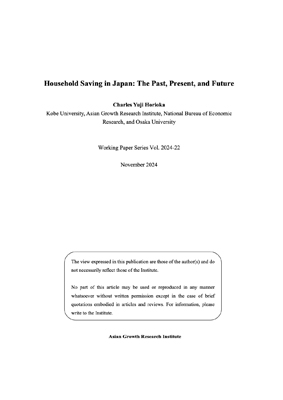Household Saving in Japan: The Past, Present, and Future

| 執筆者 | チャールズ・ユウジ・ホリオカ |
|---|---|
| 発行年月 | 2024年 11月 |
| No. | 2024-22 |
| ダウンロード | 344KB |
内容紹介
The primary objective of this paper is to explore the determinants of the level of, and trends over time in, Japan’s household saving rate, with emphasis on the impact of the age structure of the population, and to make projections about future trends therein. The paper finds that Japan’s household saving rate has not always been high either absolutely or relative to other countries, contrary to popular belief, and that, if we confine ourselves to the postwar period, it was only during the 25-year period from 1961 to 1986 that it exceeded 15%. Past and future trends in Japan’s household saving rate can largely be explained by changes in the age structure of her population, but declines in the saving rate of retired elderly households is a more important explanation for the recent decline in the household saving rate. However, it is likely that other factors such as the unavailability of consumer credit, the unavailability of social safety nets, high rates of economic (income) growth, tax breaks for saving, saving promotion policies, and high and rising land and housing prices are also partial explanations for why Japan’s aggregate household saving rate was so high during the 1961-86 period and why it declined so much subsequently. As for future trends in Japan’s aggregate household saving rate, it is likely to fall even further though not necessarily at a rapid rate.
